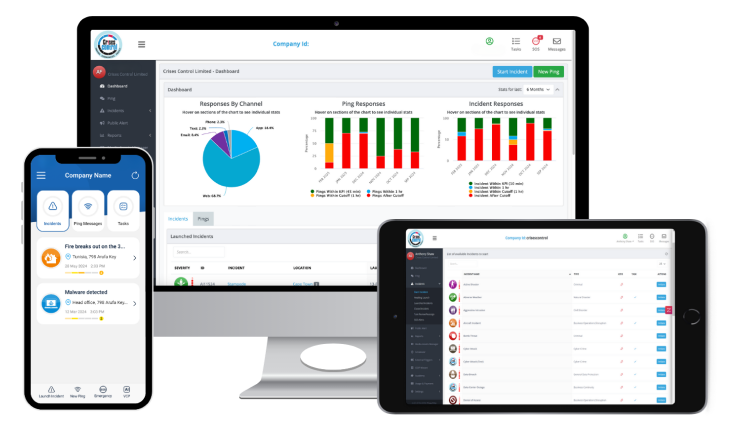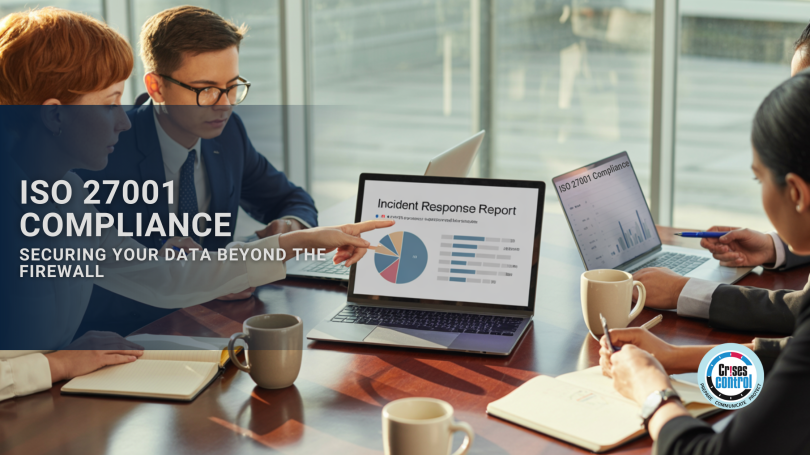Written by Anneri Fourie | Crises Control Executive
Introduction: A Real Risk, A Real Solution
Imagine this: more than 40% of UK businesses reported having a cyber breach or attack in the last year, and nearly half of medium to large enterprises experienced a cybercrime incident. According to the UK Cyber Security Breaches Survey, around 43% of businesses and 30% of charities were affected in the past year. Faced with such odds, many organisations feel exposed. They rely on firewalls and antivirus tools, but when human error or ransomware strikes, that perimeter melts away.
ISO 27001 compliance does not just assert you have a secure system, it ensures you have the right structure to detect, respond to, and recover from incidents. In this article, we’ll pinpoint the problem, explain how Crises Control offers a real solution, and help you see how to build resilience that lasts.
Why ISO 27001 Compliance Sets a Higher Bar
ISO 27001 is the international standard for an Information Security Management System (ISMS). It goes beyond technical defences to include how your people, processes, and technology align under a systematic approach to risk. Getting certified shows regulators, partners, and clients that your organisation can:
- Recognise and manage security risks
- Act swiftly during incidents
- Provide verifiable proof of controls working over time
It’s not about ticking boxes. It’s about building trust, meeting regulatory needs, and laying the foundations for continuity, and that can make all the difference when things go wrong.
Barriers Standing Between You and ISO 27001
Here are some of the main roadblocks organisations commonly face:
- Disjointed systems: Relying on emails, spreadsheets, and informal calls leaves you with blind spots you may not realise until something fails.
- Lack of audit-ready evidence: ISO auditors expect proof. If all your documentation is in someone’s head or messy files, you won’t inspire confidence.
- Slow response times: If no one knows what to do or who’s responsible during an incident, delays multiply risk.
- Insecure communication: Sharing sensitive updates over consumer-grade apps leaves you exposed and non-compliant.
- A compliance mindset gap: When teams assume risk belongs to IT alone, you miss the broader cultural change ISO demands.
To meet ISO 27001, organisations need more than policies; they need a structure that works in real time.
Incident Management Software: Structured, Fast, Evident
One essential tool is incident management software, and it solves a number of those barriers:
- Reliable workflows: Every incident follows a defined, repeatable path, so nothing slips through the cracks.
- Real-time alerts: The moment you detect an issue, the right people are notified, and everyone recalibrates fast.
- Built-in audit trail: Logs record every step, from alerting to resolution, ready for proof during audits.
- Defined roles and tasks: You know who’s doing what, when, and you can track progress transparently.
That clarity and agility turns ISO 27001 from a compliance hassle into a driver of operational strength.
Secure Crisis Communication: Reliable, Encrypted, Compliant
You can have a plan, but if your teams communicate insecurely during a critical event, the risk of data leakage spikes.
Effective secure crisis communication means:
- Messages are encrypted end-to-end so they cannot be intercepted.
- Communication works across multiple channels, so no one misses the alert.
- The solution stays accessible even if parts of your infrastructure have failed.
Crises Control provides exactly these capabilities, keeping your incident response fast and secure.
ISO 27001 Information Security Management Tools That Actually Work
Policy documents are a start, but they don’t deliver day-to-day assurance. You need actionable tools:
- Automated incident reporting, complete with time-stamped logs.
- Simulation exercises, so your teams practice responses and stay sharp.
- Dashboard views, giving auditors quick access to evidence in one place.
- Granular access controls, ensuring sensitive information is only seen by the right people.
These tools embed the discipline of ISO 27001 into daily operations.
Automation Meets ISO: Incident Response That Doesn’t Waste Time
Speed matters when responding to breaches.
Automated incident response enables you to:
- Use playbooks tailored to risks such as phishing, malware or insider threats.
- Launch alerts and workflows immediately when an incident occurs.
- Ensure consistent execution, every time.
- Retain a full record of actions, showing compliance through documentation.
Automation removes hesitation, human error, and gives you the evidence you need in real time.
How to Protect Sensitive Data in a Business Environment
This is not just about technology, it’s also about people and habits:
- Train staff regularly to recognise threats such as phishing and weak password practices.
- Use strong encryption, whether for files at rest or messages in transit.
- Test your plans, drills help everyone understand their role when a real incident happens.
- Centralise incident logging, so nothing is left to guesswork.
- Monitor and log activity, and use those logs as proof of control.
These practices show that compliance and protection go hand in hand, not in opposition.
Crises Control in Practice: Connecting ISO 27001 to Everyday Defence
Crises Control helps you turn theory into action:
- The platform brings you incident management software that enforces clear, repeatable processes.
- Secure crisis communication ensures privacy, speed and compliance through safe, multi-channel alerts.
- Automated reporting and dashboards give auditors instant clarity, plus they prove controls are working.
- Automated response workflows cut response time and reduce chaos.
- Planning and simulation tools mean you are not waiting for an event to learn what works.
In short, Crises Control helps you build ISO 27001 compliance into an operational advantage rather than a one-off certification.
Conclusion: From Risk to Resilience
When data breaches happen, you need more than luck on your side. You need structure, speed, proof, and secure communication. ISO 27001 compliance is a framework to guide that, and the right tools make it real.
Crises Control supports organisations in embedding compliance into operational routines, helping identify risks, respond quickly, and demonstrate control, all while keeping teams aligned and informed.
If you want to see how ISO 27001 compliance can become a living system in your organisation, rather than a document stuck in a drawer, why not explore what Crises Control offers?
Contact us today to book a free demo and see how compliance, communication and control come together.
Request a FREE Demo

